UGB 163 - Introduction to Accounting and Finance Assignment Analysis
VerifiedAdded on 2023/01/10
|14
|3931
|79
Homework Assignment
AI Summary
This assignment solution for UGB 163, Introduction to Accounting and Finance, addresses a series of financial and accounting problems. Part A focuses on the creation of an income statement and balance sheet for Racca Limited, providing insights into the company's financial performance and position. Part B delves into management accounting, calculating contribution, breakeven points, and margin of safety for Stockstone Ltd, alongside a strategic analysis of marketing expenditure. Part C explores investment appraisal techniques, including payback period, accounting rate of return, and net present value, to evaluate a machine purchase for Rockham Plc. The solution also discusses the merits and limitations of these techniques and the role of budgeting in strategic planning, providing a comprehensive overview of key accounting and finance concepts.
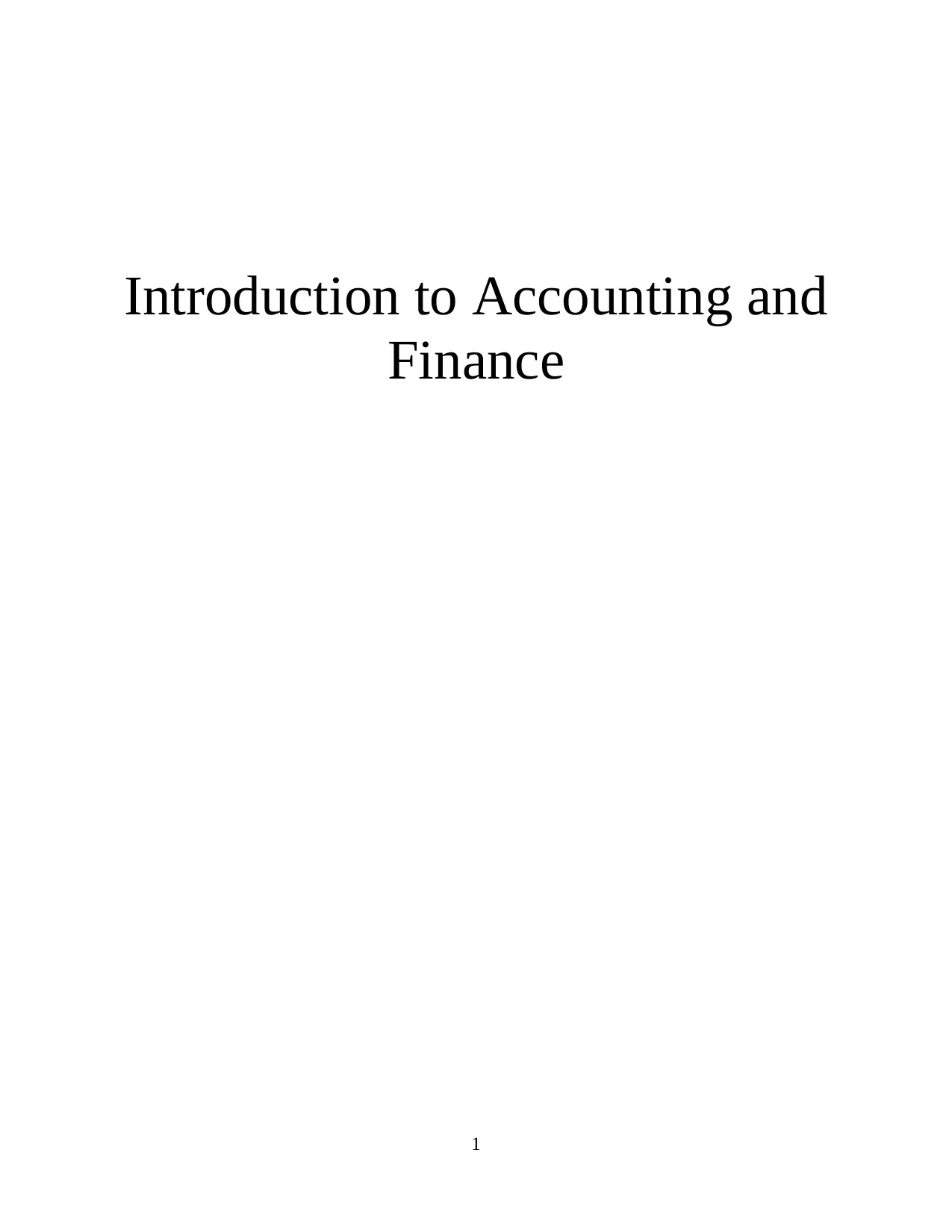
Introduction to Accounting and
Finance
1
Finance
1
Paraphrase This Document
Need a fresh take? Get an instant paraphrase of this document with our AI Paraphraser
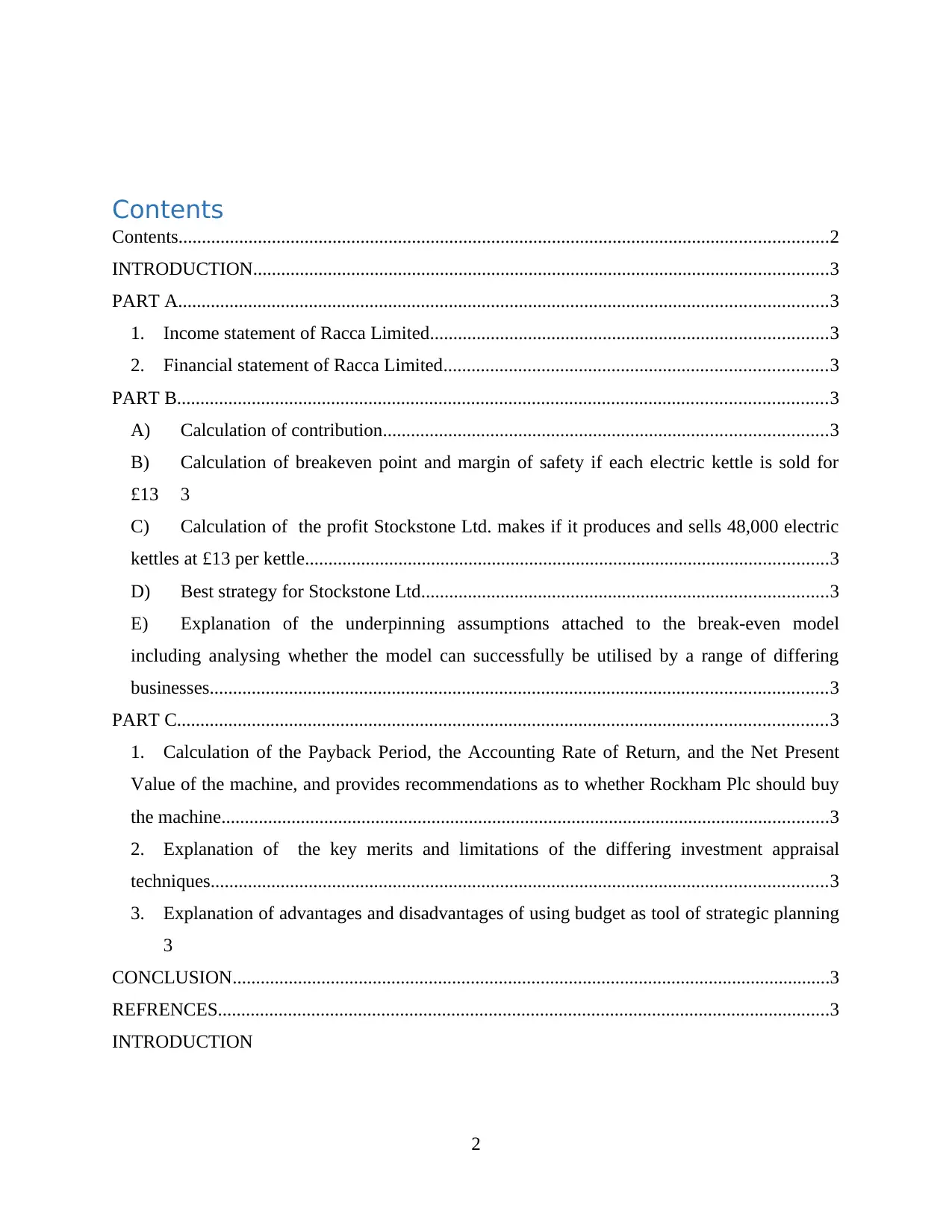
Contents
Contents...........................................................................................................................................2
INTRODUCTION...........................................................................................................................3
PART A...........................................................................................................................................3
1. Income statement of Racca Limited.....................................................................................3
2. Financial statement of Racca Limited..................................................................................3
PART B...........................................................................................................................................3
A) Calculation of contribution...............................................................................................3
B) Calculation of breakeven point and margin of safety if each electric kettle is sold for
£13 3
C) Calculation of the profit Stockstone Ltd. makes if it produces and sells 48,000 electric
kettles at £13 per kettle................................................................................................................3
D) Best strategy for Stockstone Ltd.......................................................................................3
E) Explanation of the underpinning assumptions attached to the break-even model
including analysing whether the model can successfully be utilised by a range of differing
businesses....................................................................................................................................3
PART C...........................................................................................................................................3
1. Calculation of the Payback Period, the Accounting Rate of Return, and the Net Present
Value of the machine, and provides recommendations as to whether Rockham Plc should buy
the machine..................................................................................................................................3
2. Explanation of the key merits and limitations of the differing investment appraisal
techniques....................................................................................................................................3
3. Explanation of advantages and disadvantages of using budget as tool of strategic planning
3
CONCLUSION................................................................................................................................3
REFRENCES...................................................................................................................................3
INTRODUCTION
2
Contents...........................................................................................................................................2
INTRODUCTION...........................................................................................................................3
PART A...........................................................................................................................................3
1. Income statement of Racca Limited.....................................................................................3
2. Financial statement of Racca Limited..................................................................................3
PART B...........................................................................................................................................3
A) Calculation of contribution...............................................................................................3
B) Calculation of breakeven point and margin of safety if each electric kettle is sold for
£13 3
C) Calculation of the profit Stockstone Ltd. makes if it produces and sells 48,000 electric
kettles at £13 per kettle................................................................................................................3
D) Best strategy for Stockstone Ltd.......................................................................................3
E) Explanation of the underpinning assumptions attached to the break-even model
including analysing whether the model can successfully be utilised by a range of differing
businesses....................................................................................................................................3
PART C...........................................................................................................................................3
1. Calculation of the Payback Period, the Accounting Rate of Return, and the Net Present
Value of the machine, and provides recommendations as to whether Rockham Plc should buy
the machine..................................................................................................................................3
2. Explanation of the key merits and limitations of the differing investment appraisal
techniques....................................................................................................................................3
3. Explanation of advantages and disadvantages of using budget as tool of strategic planning
3
CONCLUSION................................................................................................................................3
REFRENCES...................................................................................................................................3
INTRODUCTION
2
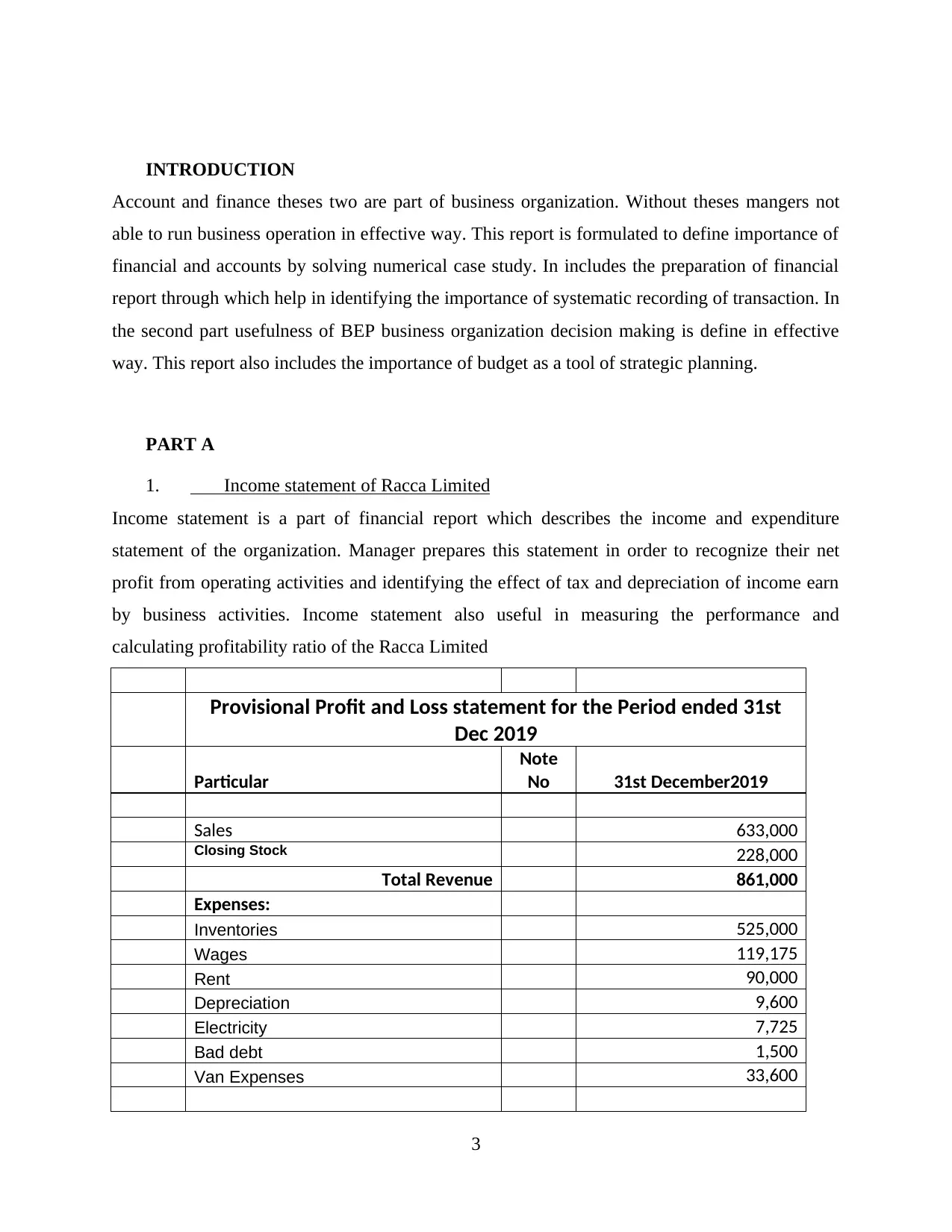
INTRODUCTION
Account and finance theses two are part of business organization. Without theses mangers not
able to run business operation in effective way. This report is formulated to define importance of
financial and accounts by solving numerical case study. In includes the preparation of financial
report through which help in identifying the importance of systematic recording of transaction. In
the second part usefulness of BEP business organization decision making is define in effective
way. This report also includes the importance of budget as a tool of strategic planning.
PART A
1. Income statement of Racca Limited
Income statement is a part of financial report which describes the income and expenditure
statement of the organization. Manager prepares this statement in order to recognize their net
profit from operating activities and identifying the effect of tax and depreciation of income earn
by business activities. Income statement also useful in measuring the performance and
calculating profitability ratio of the Racca Limited
Provisional Profit and Loss statement for the Period ended 31st
Dec 2019
Particular
Note
No 31st December2019
Sales 633,000
Closing Stock 228,000
Total Revenue 861,000
Expenses:
Inventories 525,000
Wages 119,175
Rent 90,000
Depreciation 9,600
Electricity 7,725
Bad debt 1,500
Van Expenses 33,600
3
Account and finance theses two are part of business organization. Without theses mangers not
able to run business operation in effective way. This report is formulated to define importance of
financial and accounts by solving numerical case study. In includes the preparation of financial
report through which help in identifying the importance of systematic recording of transaction. In
the second part usefulness of BEP business organization decision making is define in effective
way. This report also includes the importance of budget as a tool of strategic planning.
PART A
1. Income statement of Racca Limited
Income statement is a part of financial report which describes the income and expenditure
statement of the organization. Manager prepares this statement in order to recognize their net
profit from operating activities and identifying the effect of tax and depreciation of income earn
by business activities. Income statement also useful in measuring the performance and
calculating profitability ratio of the Racca Limited
Provisional Profit and Loss statement for the Period ended 31st
Dec 2019
Particular
Note
No 31st December2019
Sales 633,000
Closing Stock 228,000
Total Revenue 861,000
Expenses:
Inventories 525,000
Wages 119,175
Rent 90,000
Depreciation 9,600
Electricity 7,725
Bad debt 1,500
Van Expenses 33,600
3
⊘ This is a preview!⊘
Do you want full access?
Subscribe today to unlock all pages.

Trusted by 1+ million students worldwide
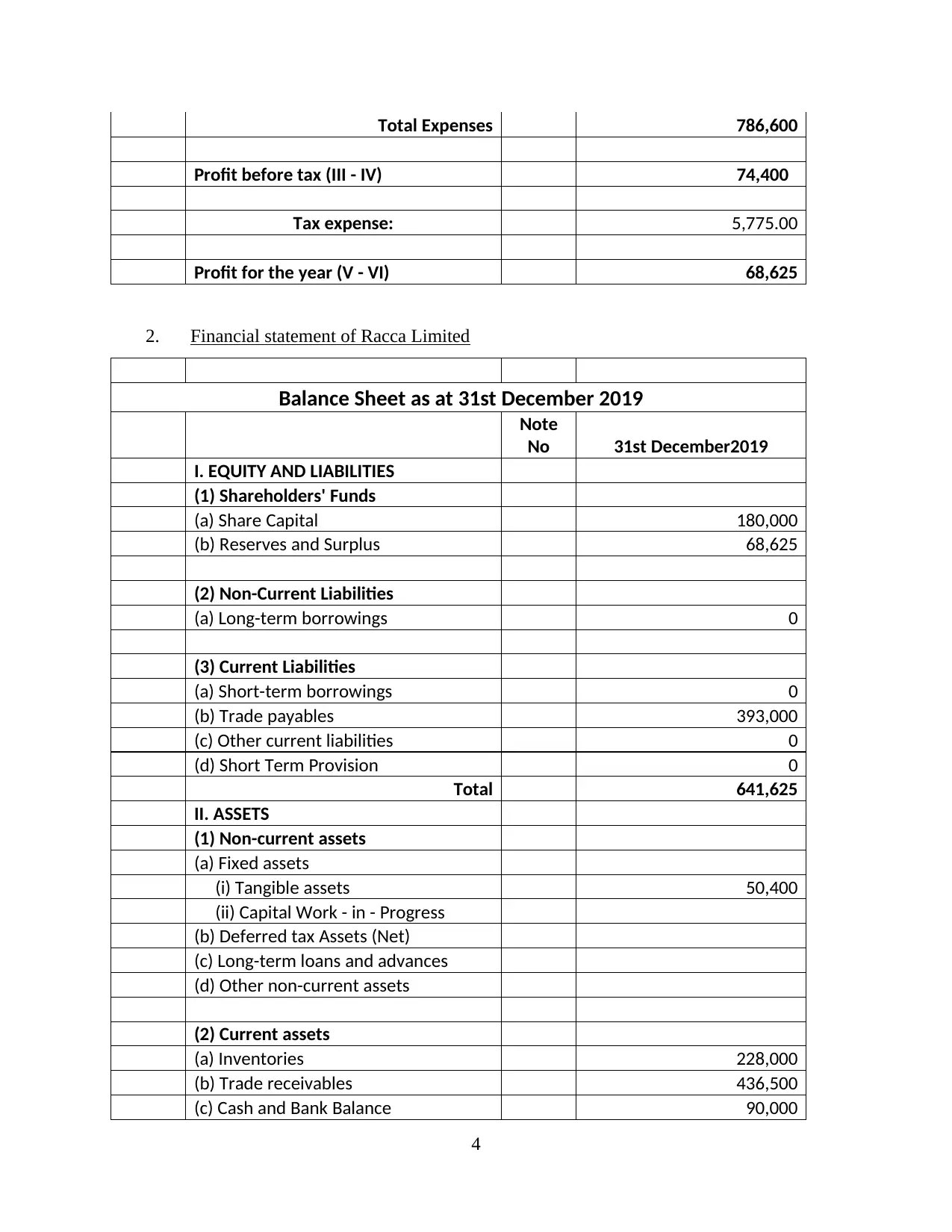
Total Expenses 786,600
Profit before tax (III - IV) 74,400
Tax expense: 5,775.00
Profit for the year (V - VI) 68,625
2. Financial statement of Racca Limited
Balance Sheet as at 31st December 2019
Note
No 31st December2019
I. EQUITY AND LIABILITIES
(1) Shareholders' Funds
(a) Share Capital 180,000
(b) Reserves and Surplus 68,625
(2) Non-Current Liabilities
(a) Long-term borrowings 0
(3) Current Liabilities
(a) Short-term borrowings 0
(b) Trade payables 393,000
(c) Other current liabilities 0
(d) Short Term Provision 0
Total 641,625
II. ASSETS
(1) Non-current assets
(a) Fixed assets
(i) Tangible assets 50,400
(ii) Capital Work - in - Progress
(b) Deferred tax Assets (Net)
(c) Long-term loans and advances
(d) Other non-current assets
(2) Current assets
(a) Inventories 228,000
(b) Trade receivables 436,500
(c) Cash and Bank Balance 90,000
4
Profit before tax (III - IV) 74,400
Tax expense: 5,775.00
Profit for the year (V - VI) 68,625
2. Financial statement of Racca Limited
Balance Sheet as at 31st December 2019
Note
No 31st December2019
I. EQUITY AND LIABILITIES
(1) Shareholders' Funds
(a) Share Capital 180,000
(b) Reserves and Surplus 68,625
(2) Non-Current Liabilities
(a) Long-term borrowings 0
(3) Current Liabilities
(a) Short-term borrowings 0
(b) Trade payables 393,000
(c) Other current liabilities 0
(d) Short Term Provision 0
Total 641,625
II. ASSETS
(1) Non-current assets
(a) Fixed assets
(i) Tangible assets 50,400
(ii) Capital Work - in - Progress
(b) Deferred tax Assets (Net)
(c) Long-term loans and advances
(d) Other non-current assets
(2) Current assets
(a) Inventories 228,000
(b) Trade receivables 436,500
(c) Cash and Bank Balance 90,000
4
Paraphrase This Document
Need a fresh take? Get an instant paraphrase of this document with our AI Paraphraser
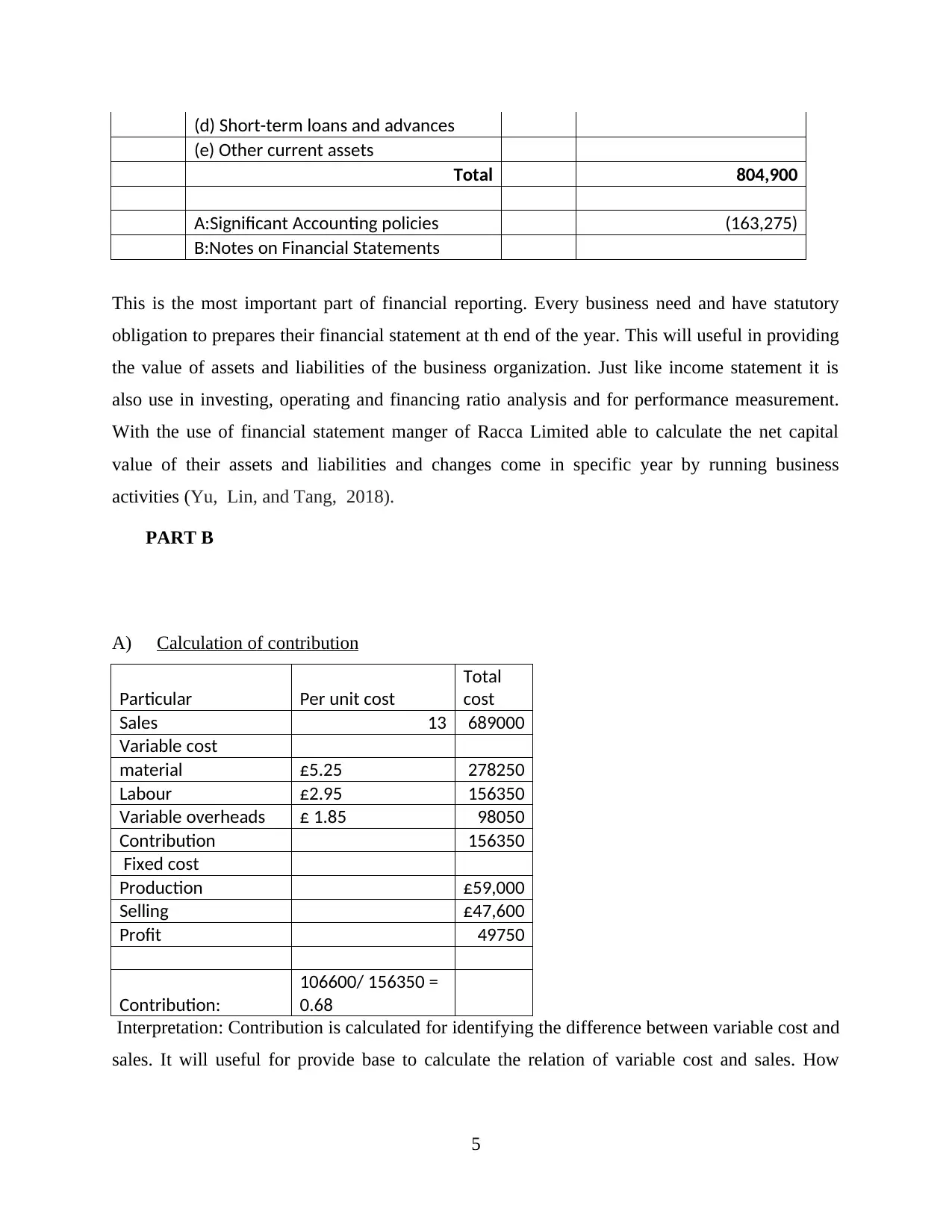
(d) Short-term loans and advances
(e) Other current assets
Total 804,900
163,275.00
A:Significant Accounting policies (163,275)
B:Notes on Financial Statements
This is the most important part of financial reporting. Every business need and have statutory
obligation to prepares their financial statement at th end of the year. This will useful in providing
the value of assets and liabilities of the business organization. Just like income statement it is
also use in investing, operating and financing ratio analysis and for performance measurement.
With the use of financial statement manger of Racca Limited able to calculate the net capital
value of their assets and liabilities and changes come in specific year by running business
activities (Yu, Lin, and Tang, 2018).
PART B
A) Calculation of contribution
Particular Per unit cost
Total
cost
Sales 13 689000
Variable cost
material £5.25 278250
Labour £2.95 156350
Variable overheads £ 1.85 98050
Contribution 156350
Fixed cost
Production £59,000
Selling £47,600
Profit 49750
Contribution:
106600/ 156350 =
0.68
Interpretation: Contribution is calculated for identifying the difference between variable cost and
sales. It will useful for provide base to calculate the relation of variable cost and sales. How
5
(e) Other current assets
Total 804,900
163,275.00
A:Significant Accounting policies (163,275)
B:Notes on Financial Statements
This is the most important part of financial reporting. Every business need and have statutory
obligation to prepares their financial statement at th end of the year. This will useful in providing
the value of assets and liabilities of the business organization. Just like income statement it is
also use in investing, operating and financing ratio analysis and for performance measurement.
With the use of financial statement manger of Racca Limited able to calculate the net capital
value of their assets and liabilities and changes come in specific year by running business
activities (Yu, Lin, and Tang, 2018).
PART B
A) Calculation of contribution
Particular Per unit cost
Total
cost
Sales 13 689000
Variable cost
material £5.25 278250
Labour £2.95 156350
Variable overheads £ 1.85 98050
Contribution 156350
Fixed cost
Production £59,000
Selling £47,600
Profit 49750
Contribution:
106600/ 156350 =
0.68
Interpretation: Contribution is calculated for identifying the difference between variable cost and
sales. It will useful for provide base to calculate the relation of variable cost and sales. How
5
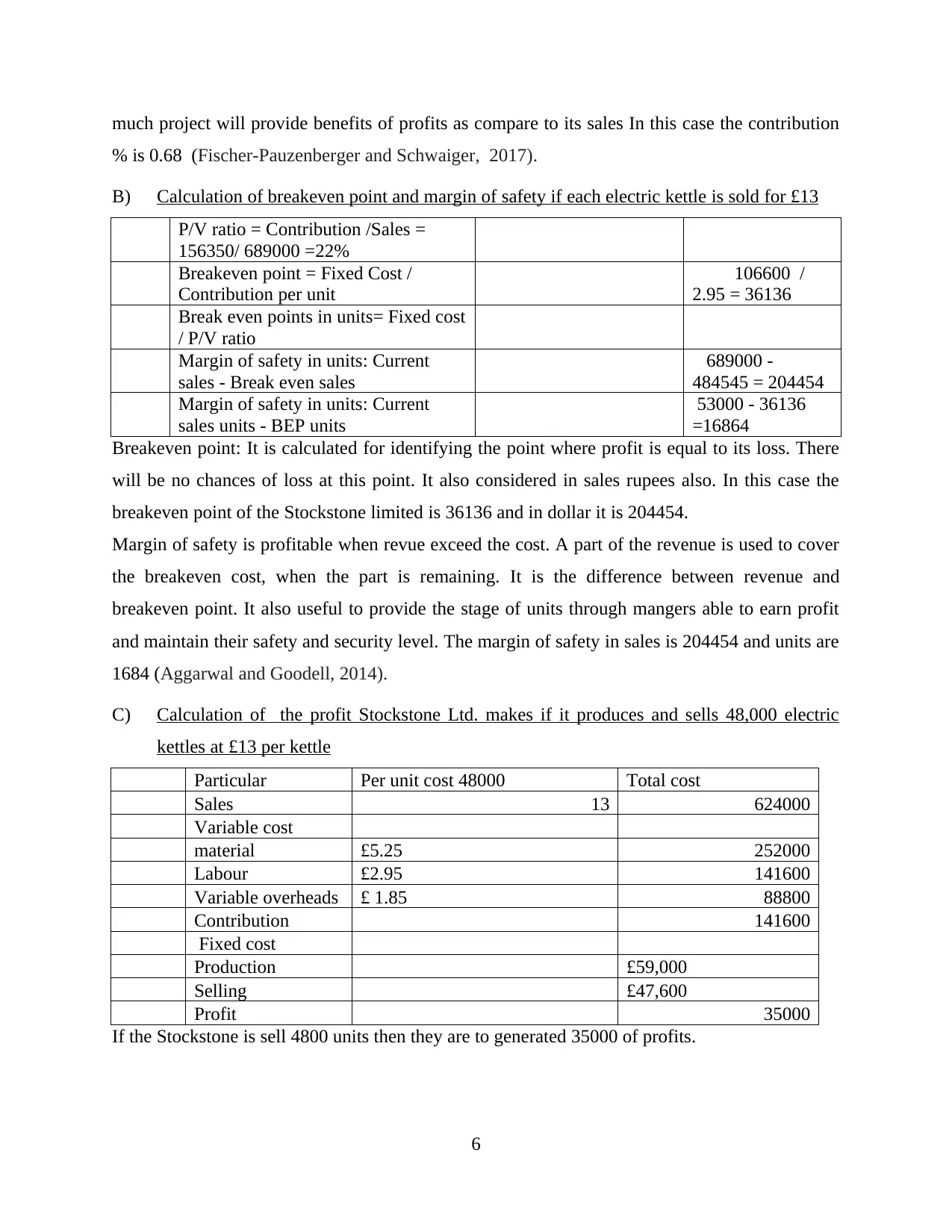
much project will provide benefits of profits as compare to its sales In this case the contribution
% is 0.68 (Fischer-Pauzenberger and Schwaiger, 2017).
B) Calculation of breakeven point and margin of safety if each electric kettle is sold for £13
P/V ratio = Contribution /Sales =
156350/ 689000 =22%
Breakeven point = Fixed Cost /
Contribution per unit
106600 /
2.95 = 36136
Break even points in units= Fixed cost
/ P/V ratio
Margin of safety in units: Current
sales - Break even sales
689000 -
484545 = 204454
Margin of safety in units: Current
sales units - BEP units
53000 - 36136
=16864
Breakeven point: It is calculated for identifying the point where profit is equal to its loss. There
will be no chances of loss at this point. It also considered in sales rupees also. In this case the
breakeven point of the Stockstone limited is 36136 and in dollar it is 204454.
Margin of safety is profitable when revue exceed the cost. A part of the revenue is used to cover
the breakeven cost, when the part is remaining. It is the difference between revenue and
breakeven point. It also useful to provide the stage of units through mangers able to earn profit
and maintain their safety and security level. The margin of safety in sales is 204454 and units are
1684 (Aggarwal and Goodell, 2014).
C) Calculation of the profit Stockstone Ltd. makes if it produces and sells 48,000 electric
kettles at £13 per kettle
Particular Per unit cost 48000 Total cost
Sales 13 624000
Variable cost
material £5.25 252000
Labour £2.95 141600
Variable overheads £ 1.85 88800
Contribution 141600
Fixed cost
Production £59,000
Selling £47,600
Profit 35000
If the Stockstone is sell 4800 units then they are to generated 35000 of profits.
6
% is 0.68 (Fischer-Pauzenberger and Schwaiger, 2017).
B) Calculation of breakeven point and margin of safety if each electric kettle is sold for £13
P/V ratio = Contribution /Sales =
156350/ 689000 =22%
Breakeven point = Fixed Cost /
Contribution per unit
106600 /
2.95 = 36136
Break even points in units= Fixed cost
/ P/V ratio
Margin of safety in units: Current
sales - Break even sales
689000 -
484545 = 204454
Margin of safety in units: Current
sales units - BEP units
53000 - 36136
=16864
Breakeven point: It is calculated for identifying the point where profit is equal to its loss. There
will be no chances of loss at this point. It also considered in sales rupees also. In this case the
breakeven point of the Stockstone limited is 36136 and in dollar it is 204454.
Margin of safety is profitable when revue exceed the cost. A part of the revenue is used to cover
the breakeven cost, when the part is remaining. It is the difference between revenue and
breakeven point. It also useful to provide the stage of units through mangers able to earn profit
and maintain their safety and security level. The margin of safety in sales is 204454 and units are
1684 (Aggarwal and Goodell, 2014).
C) Calculation of the profit Stockstone Ltd. makes if it produces and sells 48,000 electric
kettles at £13 per kettle
Particular Per unit cost 48000 Total cost
Sales 13 624000
Variable cost
material £5.25 252000
Labour £2.95 141600
Variable overheads £ 1.85 88800
Contribution 141600
Fixed cost
Production £59,000
Selling £47,600
Profit 35000
If the Stockstone is sell 4800 units then they are to generated 35000 of profits.
6
⊘ This is a preview!⊘
Do you want full access?
Subscribe today to unlock all pages.

Trusted by 1+ million students worldwide
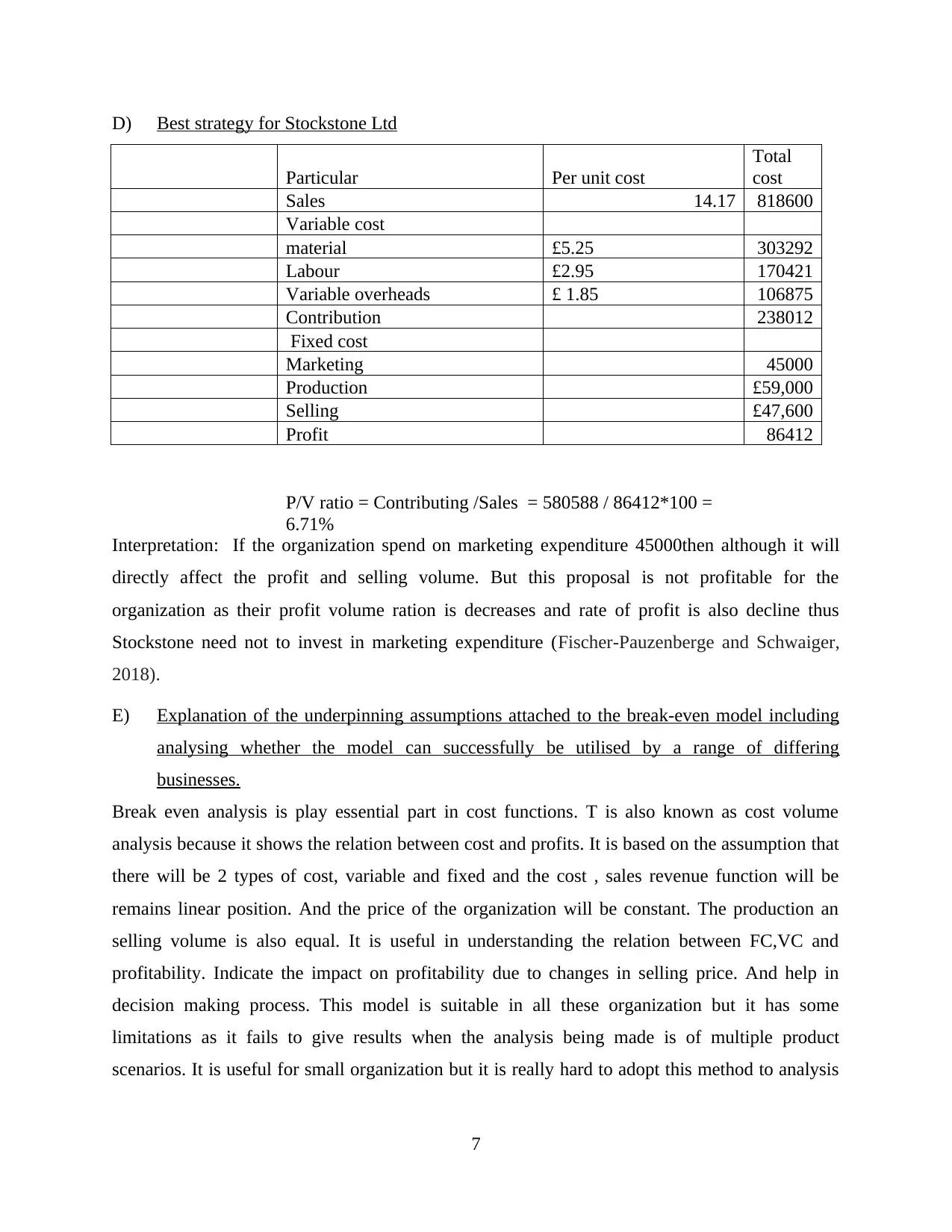
D) Best strategy for Stockstone Ltd
Particular Per unit cost
Total
cost
Sales 14.17 818600
Variable cost
material £5.25 303292
Labour £2.95 170421
Variable overheads £ 1.85 106875
Contribution 238012
Fixed cost
Marketing 45000
Production £59,000
Selling £47,600
Profit 86412
P/V ratio = Contributing /Sales = 580588 / 86412*100 =
6.71%
Interpretation: If the organization spend on marketing expenditure 45000then although it will
directly affect the profit and selling volume. But this proposal is not profitable for the
organization as their profit volume ration is decreases and rate of profit is also decline thus
Stockstone need not to invest in marketing expenditure (Fischer-Pauzenberge and Schwaiger,
2018).
E) Explanation of the underpinning assumptions attached to the break-even model including
analysing whether the model can successfully be utilised by a range of differing
businesses.
Break even analysis is play essential part in cost functions. T is also known as cost volume
analysis because it shows the relation between cost and profits. It is based on the assumption that
there will be 2 types of cost, variable and fixed and the cost , sales revenue function will be
remains linear position. And the price of the organization will be constant. The production an
selling volume is also equal. It is useful in understanding the relation between FC,VC and
profitability. Indicate the impact on profitability due to changes in selling price. And help in
decision making process. This model is suitable in all these organization but it has some
limitations as it fails to give results when the analysis being made is of multiple product
scenarios. It is useful for small organization but it is really hard to adopt this method to analysis
7
Particular Per unit cost
Total
cost
Sales 14.17 818600
Variable cost
material £5.25 303292
Labour £2.95 170421
Variable overheads £ 1.85 106875
Contribution 238012
Fixed cost
Marketing 45000
Production £59,000
Selling £47,600
Profit 86412
P/V ratio = Contributing /Sales = 580588 / 86412*100 =
6.71%
Interpretation: If the organization spend on marketing expenditure 45000then although it will
directly affect the profit and selling volume. But this proposal is not profitable for the
organization as their profit volume ration is decreases and rate of profit is also decline thus
Stockstone need not to invest in marketing expenditure (Fischer-Pauzenberge and Schwaiger,
2018).
E) Explanation of the underpinning assumptions attached to the break-even model including
analysing whether the model can successfully be utilised by a range of differing
businesses.
Break even analysis is play essential part in cost functions. T is also known as cost volume
analysis because it shows the relation between cost and profits. It is based on the assumption that
there will be 2 types of cost, variable and fixed and the cost , sales revenue function will be
remains linear position. And the price of the organization will be constant. The production an
selling volume is also equal. It is useful in understanding the relation between FC,VC and
profitability. Indicate the impact on profitability due to changes in selling price. And help in
decision making process. This model is suitable in all these organization but it has some
limitations as it fails to give results when the analysis being made is of multiple product
scenarios. It is useful for small organization but it is really hard to adopt this method to analysis
7
Paraphrase This Document
Need a fresh take? Get an instant paraphrase of this document with our AI Paraphraser
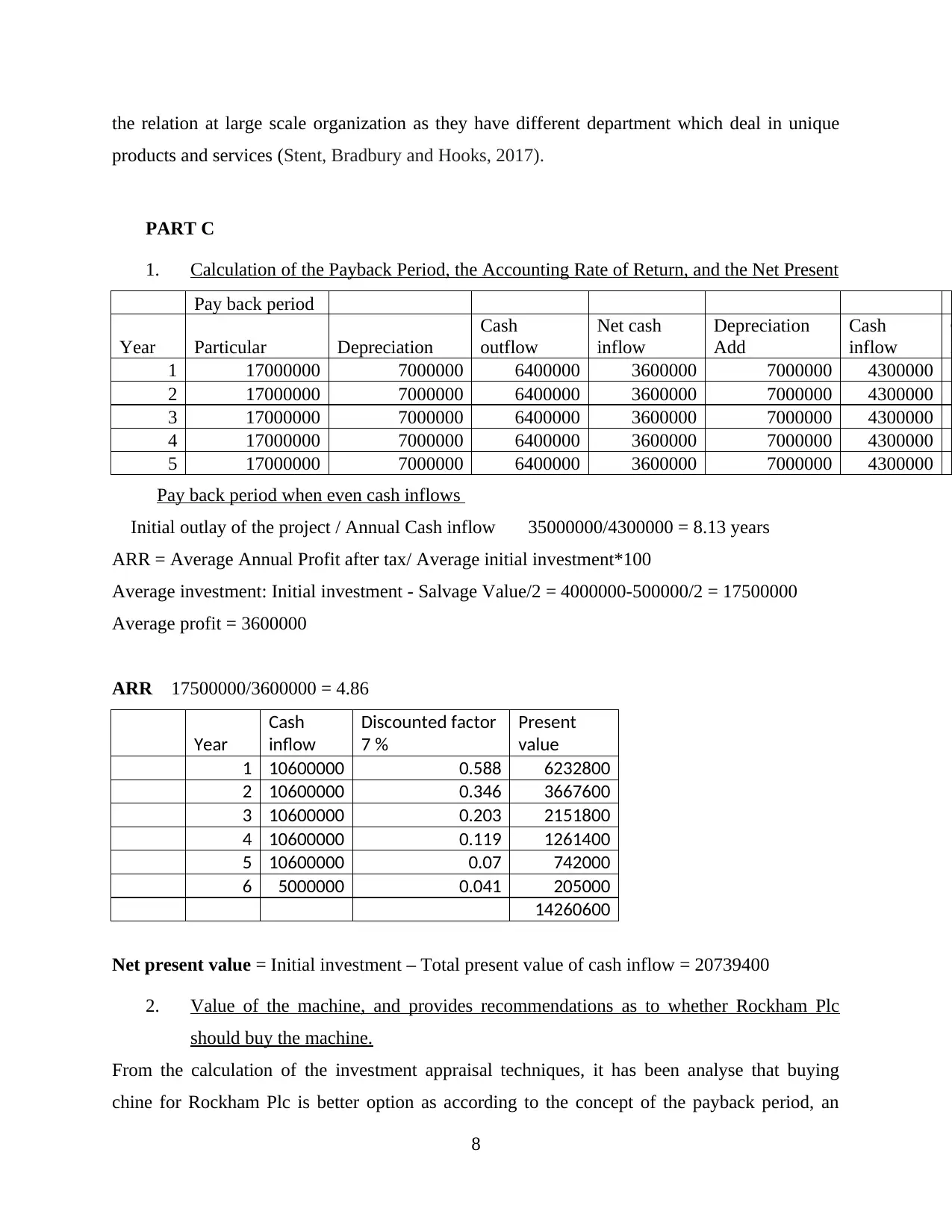
the relation at large scale organization as they have different department which deal in unique
products and services (Stent, Bradbury and Hooks, 2017).
PART C
1. Calculation of the Payback Period, the Accounting Rate of Return, and the Net Present
Pay back period
Year Particular Depreciation
Cash
outflow
Net cash
inflow
Depreciation
Add
Cash
inflow
C
I
1 17000000 7000000 6400000 3600000 7000000 4300000
2 17000000 7000000 6400000 3600000 7000000 4300000
3 17000000 7000000 6400000 3600000 7000000 4300000
4 17000000 7000000 6400000 3600000 7000000 4300000
5 17000000 7000000 6400000 3600000 7000000 4300000
Pay back period when even cash inflows
Initial outlay of the project / Annual Cash inflow 35000000/4300000 = 8.13 years
ARR = Average Annual Profit after tax/ Average initial investment*100
Average investment: Initial investment - Salvage Value/2 = 4000000-500000/2 = 17500000
Average profit = 3600000
ARR 17500000/3600000 = 4.86
Year
Cash
inflow
Discounted factor
7 %
Present
value
1 10600000 0.588 6232800
2 10600000 0.346 3667600
3 10600000 0.203 2151800
4 10600000 0.119 1261400
5 10600000 0.07 742000
6 5000000 0.041 205000
14260600
Net present value = Initial investment – Total present value of cash inflow = 20739400
2. Value of the machine, and provides recommendations as to whether Rockham Plc
should buy the machine.
From the calculation of the investment appraisal techniques, it has been analyse that buying
chine for Rockham Plc is better option as according to the concept of the payback period, an
8
products and services (Stent, Bradbury and Hooks, 2017).
PART C
1. Calculation of the Payback Period, the Accounting Rate of Return, and the Net Present
Pay back period
Year Particular Depreciation
Cash
outflow
Net cash
inflow
Depreciation
Add
Cash
inflow
C
I
1 17000000 7000000 6400000 3600000 7000000 4300000
2 17000000 7000000 6400000 3600000 7000000 4300000
3 17000000 7000000 6400000 3600000 7000000 4300000
4 17000000 7000000 6400000 3600000 7000000 4300000
5 17000000 7000000 6400000 3600000 7000000 4300000
Pay back period when even cash inflows
Initial outlay of the project / Annual Cash inflow 35000000/4300000 = 8.13 years
ARR = Average Annual Profit after tax/ Average initial investment*100
Average investment: Initial investment - Salvage Value/2 = 4000000-500000/2 = 17500000
Average profit = 3600000
ARR 17500000/3600000 = 4.86
Year
Cash
inflow
Discounted factor
7 %
Present
value
1 10600000 0.588 6232800
2 10600000 0.346 3667600
3 10600000 0.203 2151800
4 10600000 0.119 1261400
5 10600000 0.07 742000
6 5000000 0.041 205000
14260600
Net present value = Initial investment – Total present value of cash inflow = 20739400
2. Value of the machine, and provides recommendations as to whether Rockham Plc
should buy the machine.
From the calculation of the investment appraisal techniques, it has been analyse that buying
chine for Rockham Plc is better option as according to the concept of the payback period, an
8
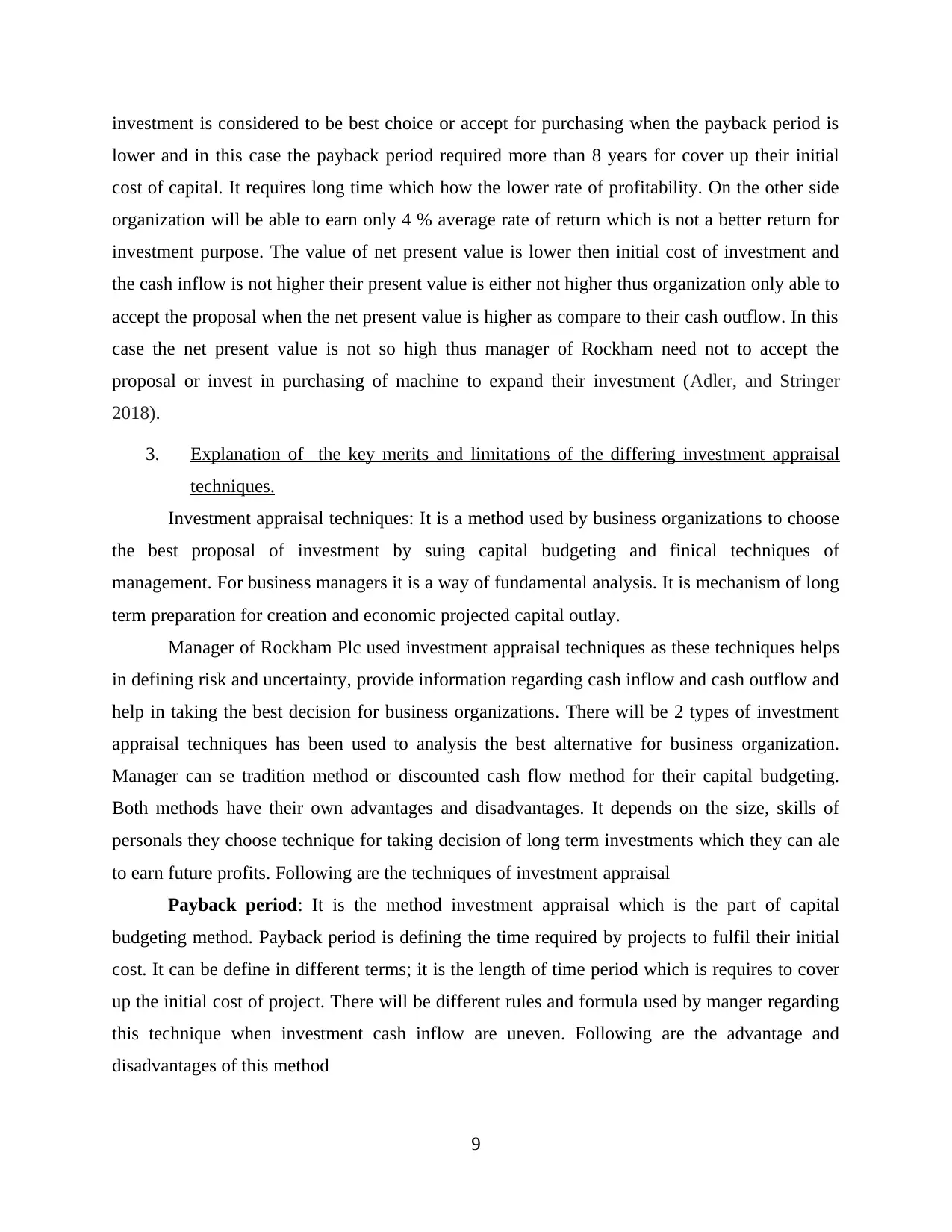
investment is considered to be best choice or accept for purchasing when the payback period is
lower and in this case the payback period required more than 8 years for cover up their initial
cost of capital. It requires long time which how the lower rate of profitability. On the other side
organization will be able to earn only 4 % average rate of return which is not a better return for
investment purpose. The value of net present value is lower then initial cost of investment and
the cash inflow is not higher their present value is either not higher thus organization only able to
accept the proposal when the net present value is higher as compare to their cash outflow. In this
case the net present value is not so high thus manager of Rockham need not to accept the
proposal or invest in purchasing of machine to expand their investment (Adler, and Stringer
2018).
3. Explanation of the key merits and limitations of the differing investment appraisal
techniques.
Investment appraisal techniques: It is a method used by business organizations to choose
the best proposal of investment by suing capital budgeting and finical techniques of
management. For business managers it is a way of fundamental analysis. It is mechanism of long
term preparation for creation and economic projected capital outlay.
Manager of Rockham Plc used investment appraisal techniques as these techniques helps
in defining risk and uncertainty, provide information regarding cash inflow and cash outflow and
help in taking the best decision for business organizations. There will be 2 types of investment
appraisal techniques has been used to analysis the best alternative for business organization.
Manager can se tradition method or discounted cash flow method for their capital budgeting.
Both methods have their own advantages and disadvantages. It depends on the size, skills of
personals they choose technique for taking decision of long term investments which they can ale
to earn future profits. Following are the techniques of investment appraisal
Payback period: It is the method investment appraisal which is the part of capital
budgeting method. Payback period is defining the time required by projects to fulfil their initial
cost. It can be define in different terms; it is the length of time period which is requires to cover
up the initial cost of project. There will be different rules and formula used by manger regarding
this technique when investment cash inflow are uneven. Following are the advantage and
disadvantages of this method
9
lower and in this case the payback period required more than 8 years for cover up their initial
cost of capital. It requires long time which how the lower rate of profitability. On the other side
organization will be able to earn only 4 % average rate of return which is not a better return for
investment purpose. The value of net present value is lower then initial cost of investment and
the cash inflow is not higher their present value is either not higher thus organization only able to
accept the proposal when the net present value is higher as compare to their cash outflow. In this
case the net present value is not so high thus manager of Rockham need not to accept the
proposal or invest in purchasing of machine to expand their investment (Adler, and Stringer
2018).
3. Explanation of the key merits and limitations of the differing investment appraisal
techniques.
Investment appraisal techniques: It is a method used by business organizations to choose
the best proposal of investment by suing capital budgeting and finical techniques of
management. For business managers it is a way of fundamental analysis. It is mechanism of long
term preparation for creation and economic projected capital outlay.
Manager of Rockham Plc used investment appraisal techniques as these techniques helps
in defining risk and uncertainty, provide information regarding cash inflow and cash outflow and
help in taking the best decision for business organizations. There will be 2 types of investment
appraisal techniques has been used to analysis the best alternative for business organization.
Manager can se tradition method or discounted cash flow method for their capital budgeting.
Both methods have their own advantages and disadvantages. It depends on the size, skills of
personals they choose technique for taking decision of long term investments which they can ale
to earn future profits. Following are the techniques of investment appraisal
Payback period: It is the method investment appraisal which is the part of capital
budgeting method. Payback period is defining the time required by projects to fulfil their initial
cost. It can be define in different terms; it is the length of time period which is requires to cover
up the initial cost of project. There will be different rules and formula used by manger regarding
this technique when investment cash inflow are uneven. Following are the advantage and
disadvantages of this method
9
⊘ This is a preview!⊘
Do you want full access?
Subscribe today to unlock all pages.

Trusted by 1+ million students worldwide
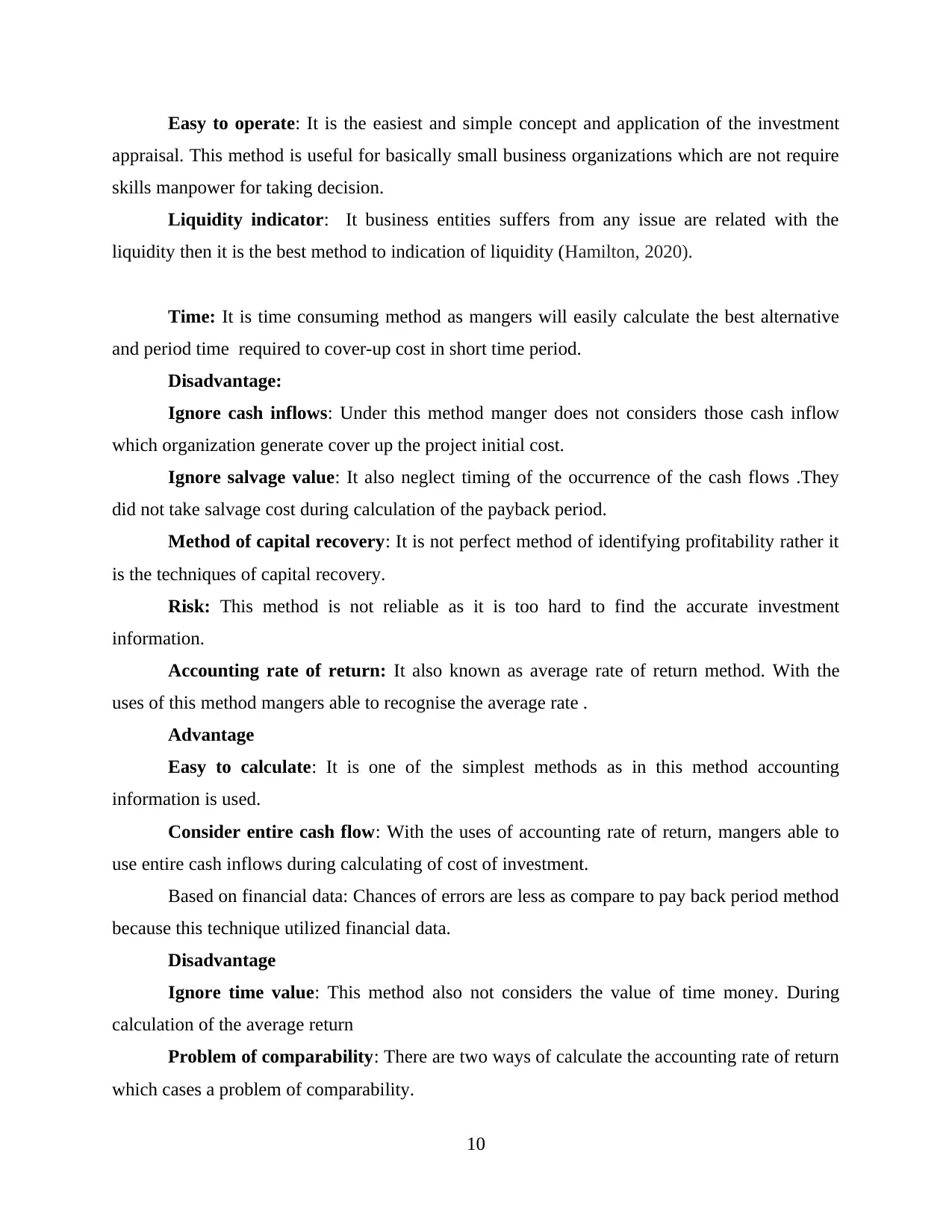
Easy to operate: It is the easiest and simple concept and application of the investment
appraisal. This method is useful for basically small business organizations which are not require
skills manpower for taking decision.
Liquidity indicator: It business entities suffers from any issue are related with the
liquidity then it is the best method to indication of liquidity (Hamilton, 2020).
Time: It is time consuming method as mangers will easily calculate the best alternative
and period time required to cover-up cost in short time period.
Disadvantage:
Ignore cash inflows: Under this method manger does not considers those cash inflow
which organization generate cover up the project initial cost.
Ignore salvage value: It also neglect timing of the occurrence of the cash flows .They
did not take salvage cost during calculation of the payback period.
Method of capital recovery: It is not perfect method of identifying profitability rather it
is the techniques of capital recovery.
Risk: This method is not reliable as it is too hard to find the accurate investment
information.
Accounting rate of return: It also known as average rate of return method. With the
uses of this method mangers able to recognise the average rate .
Advantage
Easy to calculate: It is one of the simplest methods as in this method accounting
information is used.
Consider entire cash flow: With the uses of accounting rate of return, mangers able to
use entire cash inflows during calculating of cost of investment.
Based on financial data: Chances of errors are less as compare to pay back period method
because this technique utilized financial data.
Disadvantage
Ignore time value: This method also not considers the value of time money. During
calculation of the average return
Problem of comparability: There are two ways of calculate the accounting rate of return
which cases a problem of comparability.
10
appraisal. This method is useful for basically small business organizations which are not require
skills manpower for taking decision.
Liquidity indicator: It business entities suffers from any issue are related with the
liquidity then it is the best method to indication of liquidity (Hamilton, 2020).
Time: It is time consuming method as mangers will easily calculate the best alternative
and period time required to cover-up cost in short time period.
Disadvantage:
Ignore cash inflows: Under this method manger does not considers those cash inflow
which organization generate cover up the project initial cost.
Ignore salvage value: It also neglect timing of the occurrence of the cash flows .They
did not take salvage cost during calculation of the payback period.
Method of capital recovery: It is not perfect method of identifying profitability rather it
is the techniques of capital recovery.
Risk: This method is not reliable as it is too hard to find the accurate investment
information.
Accounting rate of return: It also known as average rate of return method. With the
uses of this method mangers able to recognise the average rate .
Advantage
Easy to calculate: It is one of the simplest methods as in this method accounting
information is used.
Consider entire cash flow: With the uses of accounting rate of return, mangers able to
use entire cash inflows during calculating of cost of investment.
Based on financial data: Chances of errors are less as compare to pay back period method
because this technique utilized financial data.
Disadvantage
Ignore time value: This method also not considers the value of time money. During
calculation of the average return
Problem of comparability: There are two ways of calculate the accounting rate of return
which cases a problem of comparability.
10
Paraphrase This Document
Need a fresh take? Get an instant paraphrase of this document with our AI Paraphraser
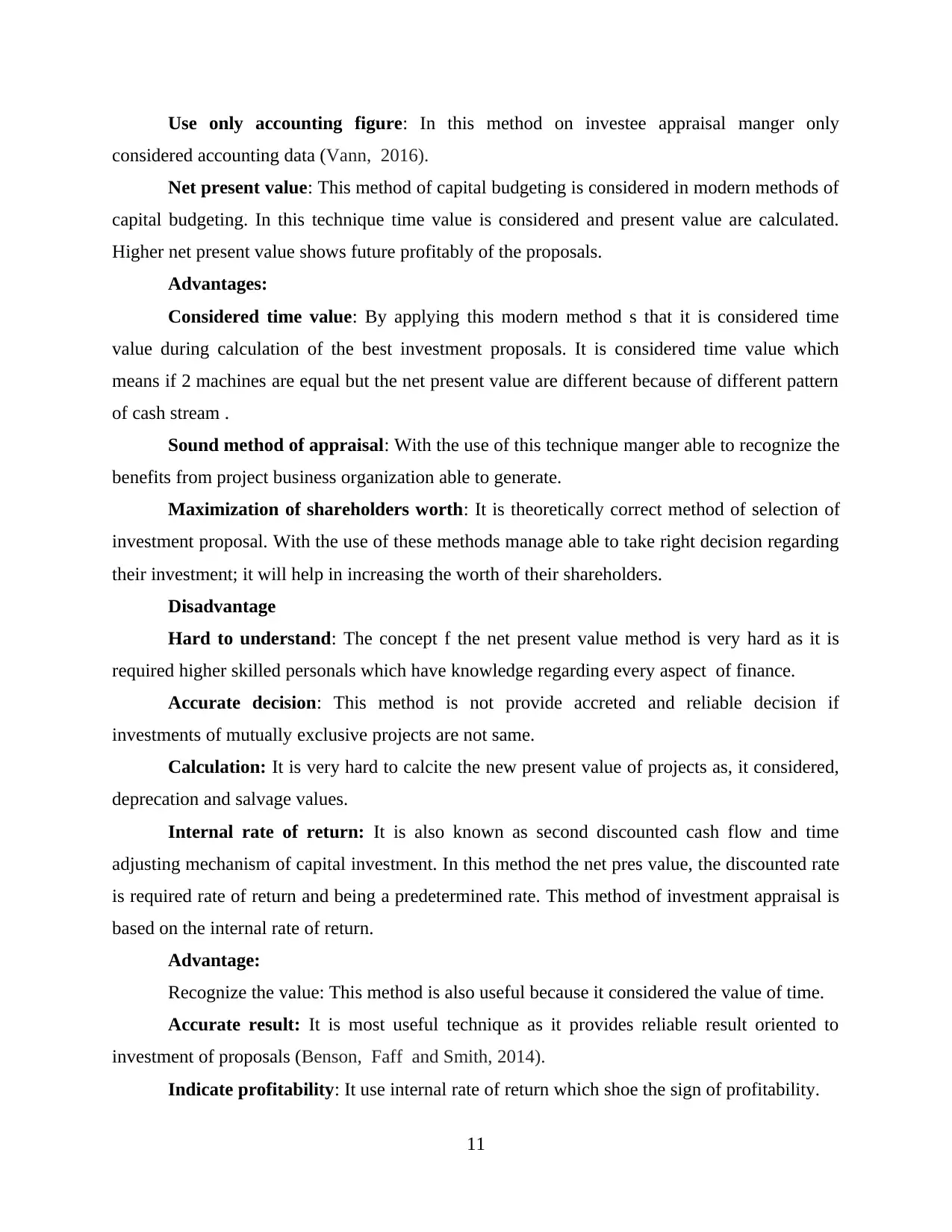
Use only accounting figure: In this method on investee appraisal manger only
considered accounting data (Vann, 2016).
Net present value: This method of capital budgeting is considered in modern methods of
capital budgeting. In this technique time value is considered and present value are calculated.
Higher net present value shows future profitably of the proposals.
Advantages:
Considered time value: By applying this modern method s that it is considered time
value during calculation of the best investment proposals. It is considered time value which
means if 2 machines are equal but the net present value are different because of different pattern
of cash stream .
Sound method of appraisal: With the use of this technique manger able to recognize the
benefits from project business organization able to generate.
Maximization of shareholders worth: It is theoretically correct method of selection of
investment proposal. With the use of these methods manage able to take right decision regarding
their investment; it will help in increasing the worth of their shareholders.
Disadvantage
Hard to understand: The concept f the net present value method is very hard as it is
required higher skilled personals which have knowledge regarding every aspect of finance.
Accurate decision: This method is not provide accreted and reliable decision if
investments of mutually exclusive projects are not same.
Calculation: It is very hard to calcite the new present value of projects as, it considered,
deprecation and salvage values.
Internal rate of return: It is also known as second discounted cash flow and time
adjusting mechanism of capital investment. In this method the net pres value, the discounted rate
is required rate of return and being a predetermined rate. This method of investment appraisal is
based on the internal rate of return.
Advantage:
Recognize the value: This method is also useful because it considered the value of time.
Accurate result: It is most useful technique as it provides reliable result oriented to
investment of proposals (Benson, Faff and Smith, 2014).
Indicate profitability: It use internal rate of return which shoe the sign of profitability.
11
considered accounting data (Vann, 2016).
Net present value: This method of capital budgeting is considered in modern methods of
capital budgeting. In this technique time value is considered and present value are calculated.
Higher net present value shows future profitably of the proposals.
Advantages:
Considered time value: By applying this modern method s that it is considered time
value during calculation of the best investment proposals. It is considered time value which
means if 2 machines are equal but the net present value are different because of different pattern
of cash stream .
Sound method of appraisal: With the use of this technique manger able to recognize the
benefits from project business organization able to generate.
Maximization of shareholders worth: It is theoretically correct method of selection of
investment proposal. With the use of these methods manage able to take right decision regarding
their investment; it will help in increasing the worth of their shareholders.
Disadvantage
Hard to understand: The concept f the net present value method is very hard as it is
required higher skilled personals which have knowledge regarding every aspect of finance.
Accurate decision: This method is not provide accreted and reliable decision if
investments of mutually exclusive projects are not same.
Calculation: It is very hard to calcite the new present value of projects as, it considered,
deprecation and salvage values.
Internal rate of return: It is also known as second discounted cash flow and time
adjusting mechanism of capital investment. In this method the net pres value, the discounted rate
is required rate of return and being a predetermined rate. This method of investment appraisal is
based on the internal rate of return.
Advantage:
Recognize the value: This method is also useful because it considered the value of time.
Accurate result: It is most useful technique as it provides reliable result oriented to
investment of proposals (Benson, Faff and Smith, 2014).
Indicate profitability: It use internal rate of return which shoe the sign of profitability.
11
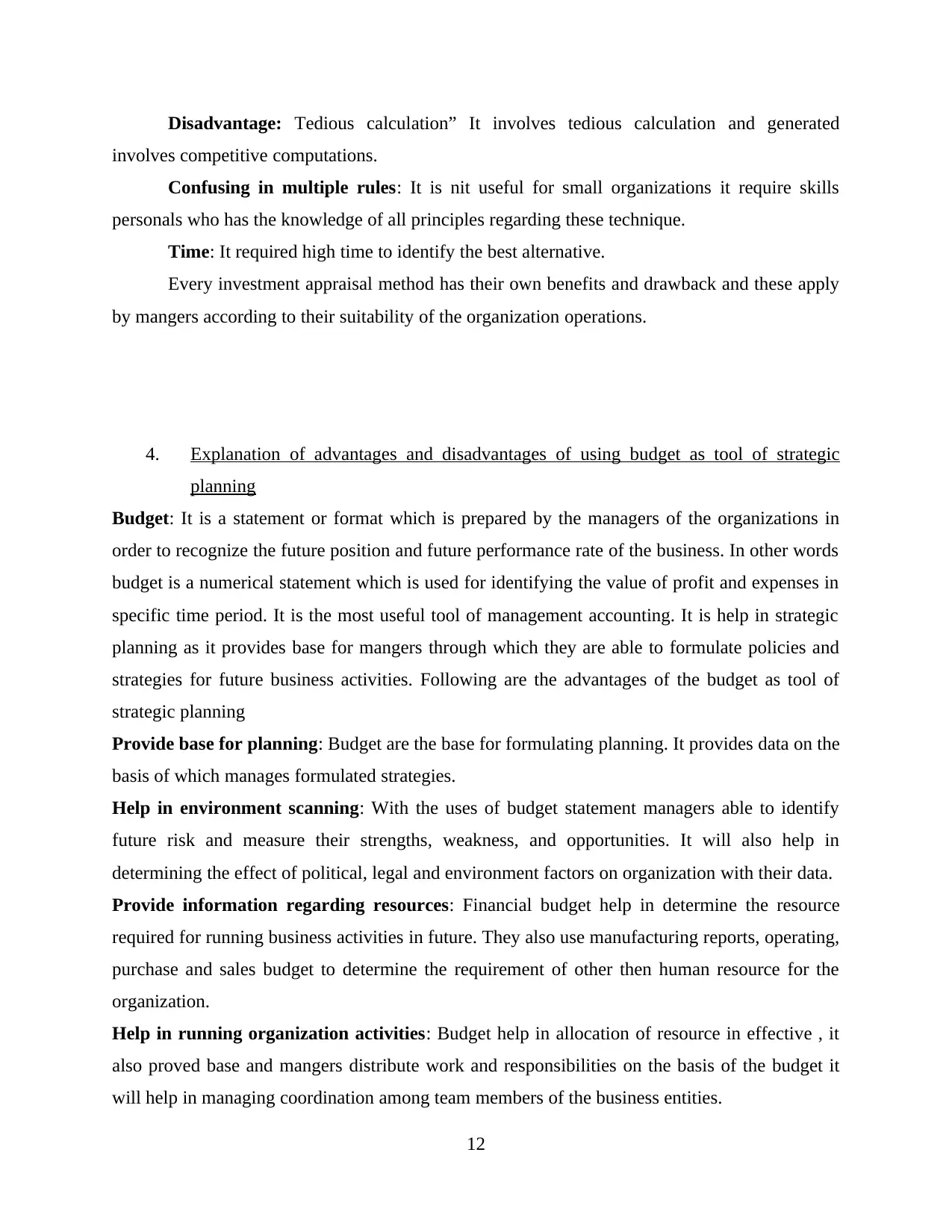
Disadvantage: Tedious calculation” It involves tedious calculation and generated
involves competitive computations.
Confusing in multiple rules: It is nit useful for small organizations it require skills
personals who has the knowledge of all principles regarding these technique.
Time: It required high time to identify the best alternative.
Every investment appraisal method has their own benefits and drawback and these apply
by mangers according to their suitability of the organization operations.
4. Explanation of advantages and disadvantages of using budget as tool of strategic
planning
Budget: It is a statement or format which is prepared by the managers of the organizations in
order to recognize the future position and future performance rate of the business. In other words
budget is a numerical statement which is used for identifying the value of profit and expenses in
specific time period. It is the most useful tool of management accounting. It is help in strategic
planning as it provides base for mangers through which they are able to formulate policies and
strategies for future business activities. Following are the advantages of the budget as tool of
strategic planning
Provide base for planning: Budget are the base for formulating planning. It provides data on the
basis of which manages formulated strategies.
Help in environment scanning: With the uses of budget statement managers able to identify
future risk and measure their strengths, weakness, and opportunities. It will also help in
determining the effect of political, legal and environment factors on organization with their data.
Provide information regarding resources: Financial budget help in determine the resource
required for running business activities in future. They also use manufacturing reports, operating,
purchase and sales budget to determine the requirement of other then human resource for the
organization.
Help in running organization activities: Budget help in allocation of resource in effective , it
also proved base and mangers distribute work and responsibilities on the basis of the budget it
will help in managing coordination among team members of the business entities.
12
involves competitive computations.
Confusing in multiple rules: It is nit useful for small organizations it require skills
personals who has the knowledge of all principles regarding these technique.
Time: It required high time to identify the best alternative.
Every investment appraisal method has their own benefits and drawback and these apply
by mangers according to their suitability of the organization operations.
4. Explanation of advantages and disadvantages of using budget as tool of strategic
planning
Budget: It is a statement or format which is prepared by the managers of the organizations in
order to recognize the future position and future performance rate of the business. In other words
budget is a numerical statement which is used for identifying the value of profit and expenses in
specific time period. It is the most useful tool of management accounting. It is help in strategic
planning as it provides base for mangers through which they are able to formulate policies and
strategies for future business activities. Following are the advantages of the budget as tool of
strategic planning
Provide base for planning: Budget are the base for formulating planning. It provides data on the
basis of which manages formulated strategies.
Help in environment scanning: With the uses of budget statement managers able to identify
future risk and measure their strengths, weakness, and opportunities. It will also help in
determining the effect of political, legal and environment factors on organization with their data.
Provide information regarding resources: Financial budget help in determine the resource
required for running business activities in future. They also use manufacturing reports, operating,
purchase and sales budget to determine the requirement of other then human resource for the
organization.
Help in running organization activities: Budget help in allocation of resource in effective , it
also proved base and mangers distribute work and responsibilities on the basis of the budget it
will help in managing coordination among team members of the business entities.
12
⊘ This is a preview!⊘
Do you want full access?
Subscribe today to unlock all pages.

Trusted by 1+ million students worldwide
1 out of 14
Related Documents
Your All-in-One AI-Powered Toolkit for Academic Success.
+13062052269
info@desklib.com
Available 24*7 on WhatsApp / Email
![[object Object]](/_next/static/media/star-bottom.7253800d.svg)
Unlock your academic potential
Copyright © 2020–2025 A2Z Services. All Rights Reserved. Developed and managed by ZUCOL.




